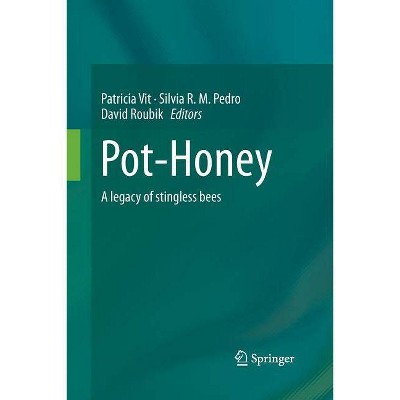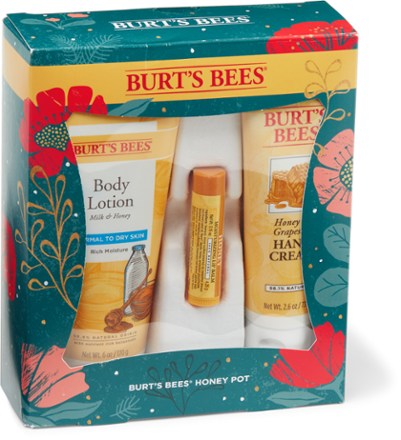Pot-Honey - by Patricia Vit & Silvia R M Pedro & David Roubik (Paperback)

Similar Products
Products of same category from the store
AllProduct info
<p/><br></br><p><b> About the Book </b></p></br></br>The stingless bees are one of the most diverse, attractive, fascinating, conspicuous and useful of all the insect groups of the tropical world. This book concentrates on honey and the stingless bees that produce it.<p/><br></br><p><b> Book Synopsis </b></p></br></br>Foreword.- Introduction.- I. Origin, biodiversity and behavior of the stingless bees (Meliponini).- 1. The Meliponini.- 2. Historical biogeography of the Meliponini (Hymenoptera, Apidae, Apinae) of the Neotropical region.- 3. Australian stingless bees.- 4. Stingless bees from Venezuela.- 5. Stingless bees (Hymenoptera: Apoidea: Meliponini) of French Guiana.- 6. Stingless bees of Guatemala.- 7. Stingless bees of Costa Rica.- 8. Stingless bees in Argentina.- 9. Mexican stingless bees (Hymenoptera: Apidae): Diversity, biogeography, and indigenous knowledge.- 10. The role of useful microorganisms to stingless bees and to stingless bee keeping.- 11. Microorganisms associated with stingless bees.- 12. Stingless bee food location communication: from the flowers to the honey pots.- 13. On competition and the diversity of food-collection strategies in stingless bees.- II. Stingless bees in culture, traditions and environment.- 14. Stingless bees: An historical perspective. 15. Medicinal uses of Melipona beecheii pot-honey, by the ancient Maya.- 16. Hans Staden's first report from 1557 on collection of stingless bee honey by an indigenous tribe in Brazil.- 17. The Melipona bee in the scientific world: Western cultural views.- 18. Taxonomy as a tool for conservation of African stingless bees and their honey.- 19. Effects of human disturbance and habitat fragmentation on stingless bees.- III. What plants are used by the stingless bees?.- 20. Palynology serving the stingless bees.- 21. How to be a bee botanist using pollen spectra.- 22. Plants used by stingless bees for nesting and as floral resources.- 23. Botanical origin of pot-honey Tetragonisca angustula Latreille in Colombia.- IV. Sensory attributes and composition of pot-honey.- 24. Sensory evaluation of pot-honey.- 25. Melipona favosa pot-honey fromVenezuela.- 26. Tetragonisca angustula pot-honey compared to Apis mellifera honey from Brazil.- 27. Honey of Colombian native bees.- 28. The pot-honey of Guatemalan stingless bees.- 29. Pot-honey of six species of Meliponini from Amboró National Park in Bolivia.- 30. Electronic nose and physicochemical analysis to differentiate Colombian pot-honey.- 31. Nuclear Magnetic Resonance as a method for molecular profiling and prediction of geographical and entomological origin of pot-honey.- 32. Non-aromatic organic acids of honeys.- V. Biological properties.- 33. Flavonoids in stingless-bee and honey-bee honeys.- 34. Antioxidant activity of pot-honey.- 35. Use of honey in cancer prevention and therapy.- 36. Bioactivity of honey and propolis from Tetragonula laeviceps in Thailand.- 37. Costa Rican pot- honey: Its medicinal use and antibacterial effect.- 38. Immunological properties of bee products.- 39. Chemical properties of propolis collected by stingless bees.- VI. Marketing and standards of pot-honey.- 40. Production and marketing of pot-honey.- Appendix.- 1. Taxonomic index of bee species.- 2. List of bee taxa.- 3. Common names of stingless bees.- 4. Taxonomic index of plant families.- 5. List of plant taxa used by bees.- 6. Common names of plants used for nesting by stingless bees.- 7. Common names of medicinal plants used with honey by Mayas.- 8. Microorganisms associated to stingless bees or used to test antimicrobial activity.- 9. Summary of meliponine and Apis mellifera honey composition.- 10. Information of collected stingless bees.- Subject list.- Authors list.<p/><br></br><p><b> From the Back Cover </b></p></br></br><p>The meliponines, stingless honey-making bees, encircle the tropical world and penetrate every forest there. This book brings together and synthesizes, on a global scale and for the first time, information on these bees as honey producers and natural alchemists. Their ability to store their food in flexible cerumen 'pots' made from wax and resin enables them to produce honey for which the world has no other source. These little known and often rare denizens of remote reaches of the globe have found a way to produce honey and survive in the permanently wet and unforgiving rain forests, since before the continents of Africa and South America split apart 100 million years ago. In Australia, we find them equipped to survive in cold deserts, and in the Amazon some feed within the nests of other social bees, utilize flesh of dead animals, or even live among scale bugs that give them food and building material. Some are obligate parasites, stealing the brood food from inside nests of other meliponines. Pot-honey is a minor honey in the market but a major honey in the forest, produced by many hundreds of flowering plants and demanding integrated conservation. Complementing the unifloral honeys of <i>Apis mellifera</i>, many more pot-honeys are yet to be appreciated by the public. The analytical corpus developed to study and standardize honey produced in combs is also valid for pot-honey. Honey ferments inside the nests of Meliponini, and the process continues after harvest. According to <i>A. mellifera </i>standards it is spoiled, yet a more medicinal product results and may remodel our concept of honey. As shown here, the meliponines, support a legacy of bees interacting with human culture, traditions, art, science and philosophy. </p><p/><br></br><p><b> Review Quotes </b></p></br></br><br><p>From the reviews: </p><p>"This up-to-date treatise ... contains an impressive amount of information about the stingless bees of the world. ... contributors provide detailed information about the diversity, cultural and historical influence, biology, and ecology of these bees throughout the work. ... it is a must-have for bee and honey researchers, students, and enthusiasts. Summing Up: Highly recommended. Upper-division undergraduates and above; general readers." (J. M. Gonzalez, Choice, Vol. 51 (1), September, 2013)</p><p>"This new publication is one of the first books specifically devoted to stingless bees. It is certainly the first to focus on the honey produced by this group of insects. ... The chapters of this book provide abundant evidence of ecological and economic importance of the stingless bees. ... this book provides enough knowledge to stimulate the realization of the nutritional and medicinal potential of pot honey." (Tim A. Heard, Archivos Latinoamericanos de Nutrición, Vol. 62 (4), 2012)</p><br>
Price History
Price Archive shows prices from various stores, lets you see history and find the cheapest. There is no actual sale on the website. For all support, inquiry and suggestion messagescommunication@pricearchive.us




















